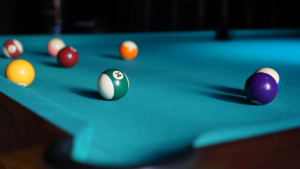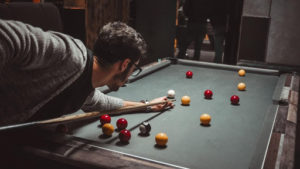Understanding the physics behind a perfect shot in pool can be a game-changer for any player. From the angle of impact to the speed of the ball, every aspect of the shot is affected by physics. In this article, we will explore the basic principles of physics that govern the dynamics of pool.
One of the most important factors in a successful shot is the angle of impact. The angle at which the cue ball strikes the object ball determines the direction in which the object ball will travel. This is governed by the law of reflection, which states that the angle of incidence is equal to the angle of reflection. By understanding this law, players can make precise calculations to ensure that their shots are accurate.
Another important factor is the speed of the ball. The speed at which the cue ball strikes the object ball determines the force with which it will travel. This is governed by Newton’s laws of motion, which state that an object in motion will remain in motion unless acted upon by an external force. By understanding these laws, players can make precise calculations to ensure that their shots have the right amount of force. That is why it’s of the utmost importance that one has a good cue to work with. And the best pool cue sale events typically occur just after Christmas.
January is the best time to go and purchase a new pool cue.
Understanding Pool Dynamics
The Role of Physics in Pool
Physics plays a crucial role in understanding pool dynamics. The game of pool involves the transfer of energy from the cue stick to the cue ball, which then transfers the energy to the object ball. The physics behind these interactions determines the trajectory and speed of the balls on the table.
Basic Concepts of Physics in Pool
There are several basic concepts of physics that are relevant to understanding pool dynamics. These include:
- Kinematics: The study of motion without considering the forces that cause the motion. In pool, kinematics is used to determine the trajectory of the balls on the table.
- Momentum: The product of an object’s mass and velocity. In pool, momentum is conserved during collisions between the balls.
- Friction: The force that opposes motion between two surfaces in contact. In pool, friction between the balls and the table affects the speed and spin of the balls.
- Elasticity: The ability of an object to deform and return to its original shape. In pool, elasticity is important for understanding how the balls bounce off each other and the table.
Understanding these basic concepts of physics is essential for mastering the game of pool. By applying these concepts, players can predict the path of the balls and make precise shots. You can click here to learn more about pool and its equipment.
The Perfect Shot
Factors Influencing the Shot
To achieve the perfect shot in pool, there are several factors that one must consider. These factors include:
- The angle of incidence of the cue ball on the object ball
- The speed of the cue ball
- The spin on the cue ball
- The position of the cue ball relative to the object ball
- The condition of the table surface
Each of these factors plays a crucial role in determining the outcome of the shot. For example, the angle of incidence of the cue ball on the object ball will determine the direction in which the object ball will move. The speed of the cue ball will determine how far the object ball will travel. The spin on the cue ball will determine the amount of spin that the object ball will have after the shot. The position of the cue ball relative to the object ball will determine the angle at which the cue ball will hit the object ball. Finally, the condition of the table surface will determine the amount of friction between the balls and the table, which will affect the speed and spin of the balls. You can buy a pool table and the best billiards equipment online.
Physics Behind the Shot
The perfect shot in pool is not just about luck or skill. It is also about understanding the physics behind the shot. The physics of pool involves the principles of motion, force, energy, and momentum.
When a cue ball strikes an object ball, the cue ball transfers its momentum to the object ball. The direction and speed of the object ball depend on the angle and speed of the cue ball, as well as the mass and elasticity of the balls. The spin on the cue ball can also affect the spin of the object ball after the shot.
To achieve the perfect shot, one must understand the physics of the shot and use it to their advantage. For example, by hitting the cue ball at a certain angle, one can make the object ball travel in a certain direction. By applying spin to the cue ball, one can make the object ball spin in a certain direction after the shot.
Overall, the perfect shot in pool requires a combination of skill, knowledge, and understanding of the physics behind the shot. By considering the factors that influence the shot and using the principles of physics, one can improve their accuracy and consistency on the pool table.
Exploring Pool Techniques
Cue Ball Control
Cue ball control is one of the most important skills in pool. It involves controlling the direction and speed of the cue ball after striking the object ball. To achieve this, players must master the art of applying spin to the cue ball.
There are several types of spin that can be applied to the cue ball, including top spin, backspin, and side spin. Top spin is applied by hitting the cue ball above its center, while backspin is applied by hitting the cue ball below its center. Side spin is applied by hitting the cue ball to the left or right of its center.
By using different types of spin, players can control the path of the cue ball and position it for their next shot. For example, top spin can be used to move the cue ball forward after hitting the object ball, while backspin can be used to stop the cue ball in its tracks.
Bank Shots and Kick Shots
Bank shots and kick shots are two advanced pool techniques that can be used to sink difficult shots. A bank shot involves hitting the object ball off the cushion before it goes into the pocket, while a kick shot involves hitting the object ball after it has bounced off one or more cushions.
To make a successful bank shot, players must first visualize the path of the object ball after it hits the cushion. They must then aim their shot to hit the cushion at the correct angle and speed to send the object ball into the pocket.
Kick shots require even more skill and precision. Players must first calculate the angle at which the object ball will bounce off the cushion before hitting it with the cue ball. This requires a deep understanding of physics and a lot of practice.
In conclusion, mastering cue ball control and advanced pool techniques like bank shots and kick shots can take years of practice. However, with dedication and patience, anyone can become a skilled pool player.
Advanced Pool Physics
Effects of Spin
When a player applies spin to the cue ball, it can affect the trajectory and spin of the object ball. The amount of spin applied can also affect the amount of friction between the cue ball and the table.
There are two types of spin: topspin and backspin. Topspin is applied by hitting the cue ball above its center, which causes the ball to spin forward. This can cause the object ball to travel farther and with less spin. Backspin is applied by hitting the cue ball below its center, which causes the ball to spin backward. This can cause the object ball to travel with more spin and less distance.
The amount of spin applied also affects the amount of friction between the cue ball and the table. The more spin applied, the more friction is created, which can cause the ball to slow down or even stop completely.
Collision and Momentum Transfer
When the cue ball collides with the object ball, momentum is transferred from one ball to the other. The angle of the collision and the mass and velocity of the balls can affect the resulting trajectory of the object ball.
The angle of the collision is important because it determines the direction in which the object ball will travel after the collision. If the cue ball hits the object ball at a 90-degree angle, the object ball will travel in the opposite direction of the cue ball. If the cue ball hits the object ball at an angle, the object ball will travel off at a different angle.
The mass and velocity of the balls also affect the resulting trajectory of the object ball. The heavier the object ball, the less it will be affected by the collision. The faster the cue ball is moving, the more momentum will be transferred to the object ball, causing it to travel farther.
Overall, understanding advanced pool physics can help players improve their game and make more accurate shots.
Conclusion
Understanding the physics behind a perfect pool shot can be a game-changer for any player. By knowing the different factors that affect the trajectory of the ball, players can make more accurate shots and improve their game.
Through this article, it is clear that there are several factors that affect the trajectory of the ball, such as the angle of incidence, speed, and spin. These factors can be manipulated by the player to achieve the desired shot.
Furthermore, understanding the concept of energy transfer and how it affects the motion of the ball is also crucial in playing pool. By knowing how the energy is transferred from the cue stick to the ball, players can adjust their shot accordingly.
Overall, mastering the physics behind pool dynamics takes time and practice. However, with the right knowledge and skills, any player can improve their game and become a better pool player.

